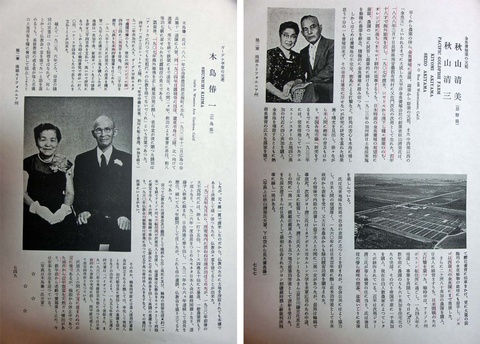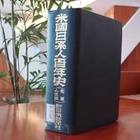Read Part 7: Japanese Americans in Southern California - Part 3 >>
A collection of over 1,000 personal histories
The second volume of the Centennial History of Japanese Americans in the United States traces the footsteps of Japanese Americans in each state, with California taking up about half of the time. On the other hand, most of the pages in each state and region are filled with introductions to numerous Japanese individuals and some organizations.
The number of people involved is more than 1,000. It is unclear how the information was actually collected, but there are records that Shinichi Kato, the editor-in-chief, ran around to personally interview people.
In Southern California, about 100 pages are devoted to introducing these individuals. The style is pretty much set.
The list includes "job title," "name (in Japanese and romanized)," "prefecture of origin in Japan," and "address in America." The main text begins with the person's place of origin, date of birth, and the names of their parents and family structure, and goes on to state what year they left Japan for, what their purpose was, and what circumstances led them to come to America.
Details of where they came from in Japan
Most of them were first-generation Japanese born in Japan, and the book includes detailed names of towns and villages, and in some cases even the names of villages, in Japan at the time. Although they were living in California around 1960 when the Centennial History was written, most of them seem to have moved around a lot for work since they set foot on American soil, and their history is briefly introduced.
Naturally, the history of the book includes the war, and the period of eviction, internment, and postwar restart, depicting half of a person's life in a time of great upheaval. Depending on the person, a full page is devoted to the book, while half a page or a quarter page is devoted to it. Most of the photos are of them in formal attire, with their families, as couples, or individually.
The chapter on "Japanese Americans in Southern California" introduces Japanese Americans in nine counties: Los Angeles County, Orange County, San Diego County, Imperial County, Riverside County, San Bernardino County, Ventura County, Santa Barbara County, and San Luis Obispo County.
From these, I would like to introduce a few people as examples of individuals, excerpting some of the original articles.
While many Japanese Americans have occupations that make use of agricultural and horticultural skills, such as landscaping, gardening, and flower gardening, San Fernando's "flower gardener, Tamekichi Endo," was born in Miho-cho, Shimizu City, Shizuoka Prefecture in 1888. "With aspirations of setting out overseas, he first traveled to Mexico in January 1907, then entered the United States and reached Colorado, where he relied on his uncle and brother, who were running a farm in Las Marias at the time, and worked as a farm worker."
After this, he returned to Japan briefly, got married, and started a flower garden with his wife. During the war, he was allowed to leave the country and moved to Ogden, Utah, with his cousin.
There are also veterans of the Russo-Japanese War and successful goldfish farming businesses.
Kijima Tsunekazu, who has the title of "Elderly of the Gardena Plain," was "born in Tadanoumi-cho, Toyota-gun, Hiroshima Prefecture in 1881. He enlisted in the 11th Infantry Regiment in Hiroshima in December 1902 and served in the Russo-Japanese War in 1904, landing on the Liaodong Peninsula and marching north, passing through Mukden and on to Tieling. During his two years there, he was promoted to sergeant for meritorious service and awarded the Order of the Eighth Class, a brave warrior of the Russo-Japanese War."
After returning to Japan, he went to Seattle in 1907 and worked there, then moved to California, where he started a chicken farming business after a while. In September 1925, oil was found on land he owned. After the war, natural gas was found from the oil well. Although there are only a few like Kijima, there are also soldiers who served in the Russo-Japanese War who appear in the article.
Orange County's Akiyama Kiyomi and his wife, Akiyama Seizo, are described as the "originators of goldfish farming." Born in Ariake Village, Minamiazumi County, Nagano Prefecture in 1888, Kiyomi came to the United States at the age of 18, coming from Seattle and eventually settling in Orange County where he worked in celery farming. After that, "he saw the potential of goldfish farming, a Japanese specialty, and while he continued this as a side job by raising them on part of his farm, he gave up farming when the California Exclusionary Land Act of 1923 came into effect and actively pursued goldfish farming."
Despite many difficulties, before the war he had developed it into the largest goldfish farm west of Chicago, and even after the war he resumed business and now grows lettuce on the land he owns.
Stories of the hardships faced by immigrants after they immigrated are also woven throughout the book. Kinzo Saruwatari (from Kumamoto Prefecture), a farmer in San Luis Obispo County, traveled to Hawaii with his wife in 1903, unusual for an immigrant, and worked in a sugarcane field. He then traveled to the mainland, where he chopped firewood and worked on farms. "The wages at the time were low, between $1 and $1.25 for a 10-hour shift, and there was no rice, so food was meager, consisting of just salted dumpling soup."
Although what has been introduced above is only a small part of it, the book provides a detailed account of each individual's journey from their arrival in America up until around 1960.
(Note: I have used the original text as much as possible, but have made some edits. In addition, I have based the names of places on the way they are written in the "Centenary History.")
© 2014 Ryusuke Kawai







